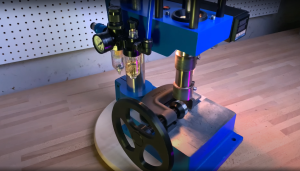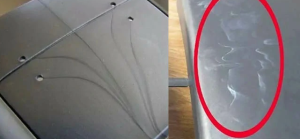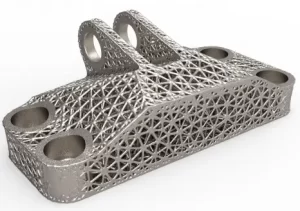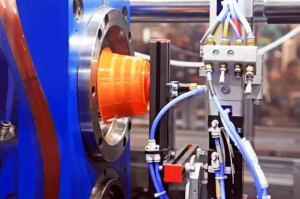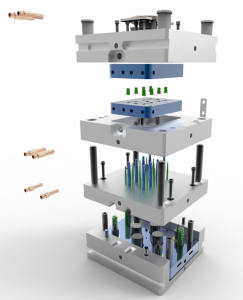Understanding the key terms used in the injection molding industry is essential for professionals to effectively communicate, optimize processes, and improve product quality. Here’s a comprehensive list of 45 must-know terms:
| 1.Injection Molding | A manufacturing process in which molten material is injected into a mold to create parts with precise shapes and dimensions. |
| 2.Mold (or Die) | A custom-designed tool that shapes the molten material into the desired part. Consists of two halves: the cavity (female part) and the core (male part). |
| 3.Mold Cavity | The hollow space in the mold that shapes the exterior of the part. |
| 4.Core | The protruding part of the mold that forms the internal features of the part. |
| 5.Runner | The channel through which molten plastic flows from the injection unit to the mold cavity. |
| 6.Sprue | The main channel that connects the injection nozzle to the runner system. |
| 7.Gate | The opening through which molten plastic enters the mold cavity. |
| 8.Flash | Excess material that leaks out of the mold cavity along the parting line, creating thin, unwanted edges on the part. |
| 9.Parting Line | The seam where the two halves of the mold meet. |
| 10.Clamping Unit | The component of the injection molding machine that holds the mold halves together during the injection process. |
| 11.Clamp Force | The pressure applied by the clamping unit to keep the mold closed during injection, measured in tons. |
| 12.Injection Unit | The part of the injection molding machine that melts and injects the material into the mold. |
| 13.Hopper | The container where raw plastic material (pellets or granules) is loaded before entering the machine. |
| 14.Barrel | The heated cylindrical chamber where the plastic material is melted. |
| 15.Screw | The rotating component inside the barrel that melts and conveys the material toward the mold. |
| 16.Nozzle | The part of the injection unit that directs the molten material into the sprue or runner system. |
| 17.Cycle Time | The total time required to produce a single molded part, including injection, cooling, and ejection. |
| 18.Cooling Time | The portion of the cycle time during which the molten material solidifies inside the mold. |
| 19.Ejector System | The mechanism that pushes the molded part out of the mold after cooling. |
| 20.Vent | Small channels in the mold that allow trapped air and gases to escape during injection. |
| 21.Shot | The amount of molten material injected into the mold during one cycle. |
| 22.Shot Size | The volume of molten material injected into the mold during a single cycle, typically measured in cubic centimeters. |
| 23.Short Shot | A defect where the mold cavity is not completely filled, resulting in an incomplete part. |
| 24.Sink Mark | A depression on the surface of a part caused by uneven cooling or insufficient packing pressure. |
| 25.Warping | The deformation of a part caused by uneven cooling or internal stress. |
| 26.Knit Line (or Weld Line) | A visible line where two flow fronts of molten material meet, often weaker than other areas. |
| 27.Overmolding | A process where one material is molded over another to create a multi-material part. |
| 28.Insert Molding | A process in which pre-made components (e.g., metal inserts) are placed into the mold before injection. |
| 29.Hot Runner System | A runner system that keeps the plastic molten, eliminating the need for solid runners and reducing waste. |
| 30.Cold Runner System | A runner system where the material solidifies in the runner and must be removed during ejection. |
| 31.Draft Angle | A slight angle added to the walls of the part to facilitate easier ejection from the mold. |
| 32.Resin | The raw plastic material used in the injection molding process. |
| 33.Thermoplastic | A type of resin that can be melted and re-melted multiple times, such as ABS, polypropylene, and nylon. |
| 34.Thermoset | A type of resin that solidifies permanently after molding and cannot be re-melted. |
| 35.Material Shrinkage | The reduction in size of the part as the plastic cools and solidifies in the mold. |
| 36.Melt Temperature | The temperature at which the plastic material becomes molten and ready for injection. |
| 37.Mold Temperature | The temperature of the mold during the injection molding process, which affects cooling and part quality. |
| 38.Packing Pressure | The additional pressure applied during the molding process to pack the molten material into the mold and reduce defects. |
| 39.Hold Time | The time during which the packing pressure is applied to the mold before cooling begins. |
| 40.Sprue Puller | A feature in the mold design that ensures the sprue is removed when the mold opens. |
| 41.Regrind | Scrap material that has been ground into smaller pieces and reused in the molding process. |
| 42.Process Window | The range of machine settings (temperature, pressure, speed) that produce high-quality parts. |
| 43.Tooling | The molds, dies, and related equipment used in the injection molding process. |
| 44.Cavitation | The number of cavities in a mold, determining how many parts can be produced per cycle (e.g., single-cavity, multi-cavity). |
| 45.Barrel Residence Time | The length of time the molten plastic remains in the barrel before being injected into the mold. |
Knowing these 45 terms is crucial for anyone involved in the injection molding industry, whether you’re a machine operator, designer, engineer, or production manager. Mastering this terminology allows for better communication, process optimization, and problem-solving across all aspects of the injection molding workflow.


